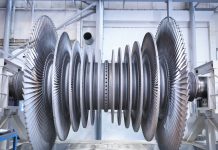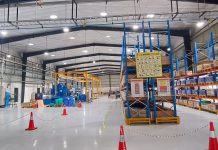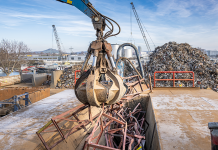Ranking as leader in the design, production and sale of motion transmission components, while respecting collaborators, customers, suppliers and environment is an ambitious target, but today to be aspiring is indispensable to be competitive.
At Bondioli & Pavesi (Suzzara near Mantova, Italy) they have always cultivated one great passion only: the power transmission. From agriculture to mobile machines, from mechanical power transmission to hydraulics and electronic components, every day Bondioli & Pavesi implements motion solutions worldwide. To grow and to act globally, the company has progressively integrated new business realities, technologies and knowledge into its structure. The result of this development course is a big industrial Group whose structure combines, harmonizing them, design, production, sale, assistance and after sale service functions.
In more than sixty years of activity, the development key has always been the great attention paid to customers’ requirements, which has resulted in a constant research and investment policy, continuous attention to productive processes and bent for the development of ideas and projects in collaboration with customers. The catalogue includes driveshafts for agriculture, standard gearboxes, for special applications, with parallel axes, valves of monoblock directional control, modular, load sensing and ByWire types, cartridge valves, servo-controls, hydraulic-, electronic and electro-hydraulic control joysticks and pedals, hydraulic feeding units, variable and fixed delivery axial-piston pumps and motors for closed circuit, variable and fixed delivery axial-piston pumps for open circuit, variable delivery axial-piston motors with inclined axis, automotive electronic systems, electronic control systems, aluminium-body gear motors and pumps, with cast iron body and of silent type, air/oil aluminium heat exchangers, combined exchangers and fan drive systems.
Significant are the three following examples.
Integrated ByPass system
Among the outfits that can equip a hydraulic oil exchanger there is the ByPass system that, under determinate operational conditions like the machine starting, allows the circulation of the fluid to be cooled outside the exchanger, to avoid excessive levels of pressure and to facilitate the attainment of the optimal operating temperature of the fluid. ByPass is fully integrated into the exchanger body.
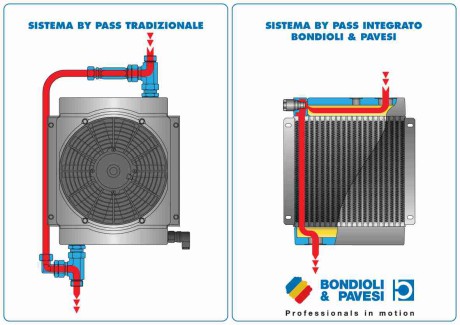
Standard ByPass systems for exchangers are composed by numerous elements like pipes, joints and valves positioned outside the exchanger. The essential innovation offered by the integrated ByPass system by Bondioli & Pavesi is the complete elimination of any component outside the exchanger. Thanks to the know how in the design and implementation of radiant masses, they have realized a specific duct-element, devoid of fins and turbolators, which is placed inside the radiant mass, where it is possible to make the fluid to be bypassed circulate. The fluid passage is controlled by a valve sensitive to the only pressure or to temperature and pressure values, which is housed inside seats drawn in the collector body. The complete in-house study and production of the radiant pass allows sizing the bypass ducts and prearranging the valve calibration according to the machine running criteria wished by the customer. The fluid pressure drop cannot exceed the bypass valve calibration, therefore the power dissipations are limited in conditions of high density and low temperature of the fluid. Moreover, the particular system structure permits the fluid circulation inside the duct-element that, being part of the radiant mass, further limits dissipations.
The fast achievement of the optimal operating temperature of the fluid is due to the integration of the ByPass circuit into the radiant mass. The reductions of the overall dimensions involve consequent advantages during the machine design. The installation needs no pipes, joints and valves outside the exchanger. There are no external elements that can break or trigger fluid leakages and then pollute the external environment. The component is protected against overpressures and water hammers, which can be caused by wrong uses or by the utilization of very dense fluids at low temperature.
ByWire distributors
Mobile operating machines must pay ever-increasing attention to the active and passive safety, to the low energy consumption (low load losses in the hydraulic circuit), they must be ergonomic and reliable, require easy maintenance and finally be user-friendly and intuitive. For this reason, electric type controls are more and more requested in distributors and, depending on the motion requirements of the machine, they can be of three types: On Off, Proportional in input, Proportional in input and output. If simultaneous motions are requested, these functions must be locally compensated or not.
The machine manufacturer calls also for flexibility in the study and implementation of the circuit, short prototyping times, self-managed solutions according to the temporary needs (for instance addition of one function on the machine), optimization of the machine circuit components, optimization of the hydraulic circuit and reduction of connections, joints and assemblies, facilitated service, stock reduction thanks to the use of modular and/or flexible components and everything else. ByWire is an evolution conceived to satisfy these requirements; it is unique of its kind and consists in interfacing a block built according to the machine circuit needs with mass-produced standard elements.
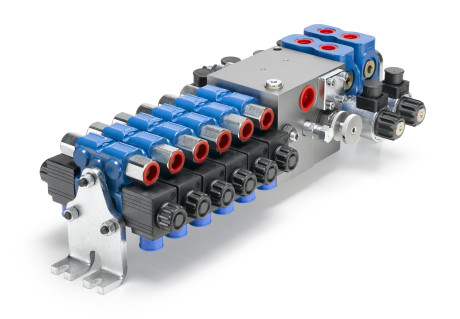
Standard elements, generally dedicated to motion functions, are equipped with specific accessories of the dedicated function, like block, modulating and flow control valves etc. To reduce load losses, and then to save energy, all exchanges and compensations are performed in the body itself and not in cartridge. The system provides reduced load losses, drastic reduction of connections, notable size and weight decrease with a consequent rise of global competitiveness.
The project lives a constant growth and today it already includes a wide quantity of circuital conditions within flow rates of 150 l/min per use. They have particularly developed specific hybrid blocks for applications on agricultural machines, mobile operating machines for municipal activities and lifting operations, earth handling and industrial application machines. Real project core are the hybrid ByWire blocks, whose operating principle, in the various configurations, is based on the flow rate distribution according to the load sensing logic. Depending on the type of hydraulic feeding unit, the block can operate with fixed or variable displacement pumps, with load sensing control or with constant pressure. The essential principles, opportunely organized, determine the various distribution logics: primary compensation, local compensation and priority compensation. The primary compensation is performed by means of a mobile box, with the triple task of keeping the pressure jump constant, irrespective of the load (bigger), discharging the flow rate in excess and/or acting as venting of the total flow rate, limiting the highest operating pressure; it represents the main stage of a pressure relief valve. The screw-type mechanical end of stroke allows shifting from open centre to closed centre with extreme facility. In the operation with fixed displacement pump and unscrewed stroke end, the flow rate delivered by the pump is discharged through the compensator: the valve cursors for the direction control are in central position (electro-magnets not excited).
The flow rate that crosses the compensator determines the stand-by pressure value. When one of the cursors of the valves for the direction control is operated, the highest pressure is reflected in the spring-side chamber of the compensator, which keeps the pressure jump constant. With LS variable displacement pump and screwed end of stroke, the load pressure signal is sent to the pump by an apposite port. If directional valves are not excited, the LS signal is low and on the pump flow is applied the stand-by pressure imposed by the differential limiter. When an element for the flow rate direction control is operated, the load pressure signal is sent to the pump regulator and the pressure drop between P and LS remains unchanged. Through the local compensation, it is possible to implement a multi-user compensated system. Local compensators grant a constant flow rate to users irrespective of the external load. The law that rules the user flow rate is linked by a proportionality relation with the passage section. The system must not work under saturation conditions because this compromises the use of the hybrid block and the load instability. The priority compensation is used to grant a constant and priority flow rate, irrespective of the load and flow rate conditions of auxiliary users. The pressure signal, which constantly monitors the state of the priority user, is reflected to the priority cursor and to the main compensator, granting the highest response speed in case of flow rate request.
A cardan driveline for big powers
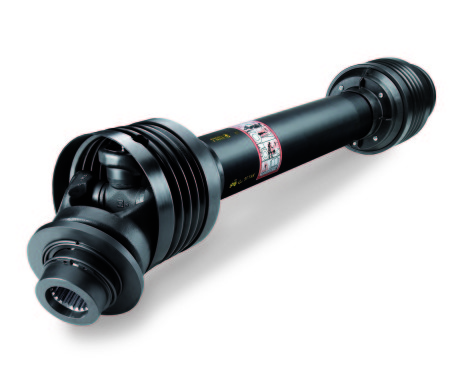
From the combination of Bondioli & Pavesi experience and the character of SFT transmissions springs SK, the safe, functional and technological driveshaft to face the most demanding power transmission requirements in agriculture, without giving up any of the qualities that have made the SFT family the technological reference point in the cardan driveline world.
The driveshaft is equipped with 2¼“- Z22 drive forks with “heavy duty“ ball collar. Spiders are designed and manufactured for heavy loads (500 HP tractors) and severe applications in agriculture. The “Advanced Four Tooth Profiles“ telescopic elements are specifically sized to provide the highest twisting strength and an extended contact surface for a long duration of the telescopic motion. Compact SFT protection despite the big sizes of the shaft. The standard lubrication interval of 50 hours can be extended up to 250 hours under determinate use conditions.

